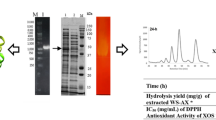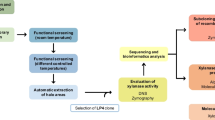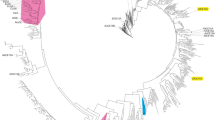Abstract
To develop new cellulases for efficient utilization of the lignocellulose, an endoglucanase (CoCel5A) gene from Colletotrichum orchidophilum was synthesized and a recombinant Pichia pastoris GS115/pPIC9K/cocel5A was constructed for secretory expression of CoCel5A. After purification, the protein CoCel5A was biochemically characterized. The endoglucanase CoCel5A exhibited the optimal activity at 55–75 °C and high thermostability (about 85% residual activity) at the temperature of 55 °C after incubation for 3 h. The highest activity of CoCel5A was detected when 100 mM citric acid buffer (pH 4.0–5.0) was used and excellent pH stability (up to 95% residual activity) was observed after incubation in 100 mM citric acid buffer (pH 3.0–6.0) at 4 °C for 24 h. Carboxymethyl cellulose sodium salt (n = approx. 500) (CMC) and β-d-glucan were the best substrates for CoCel5A among the tested substrates. The kinetic parameters Vmax, Km, and Kcat/Km values against CMC were 290.70 U/mg, 2.65 mg/mL, and 75.67 mL/mg/s, respectively; and 228.31 U/mg, 2.06 mg/mL, and 76.45 mL/mg/s against β-d-glucan, respectively, suggesting that CoCel5A has high affinity and catalytic efficiency. These properties supported the potential application of CoCel5A in biotechnological and environmental fields.




Similar content being viewed by others
References
Prasad RK, Chatterjee S, Mazumder PB, Gupta SK, Sharma S, Vairale MG, Datta S, Dwivedi SK, Gupta DK (2019) Bioethanol production from waste lignocelluloses: a review on microbial degradation potential. Chemosphere 231:588–606
Aditiya HB, Mahlia TMI, Chong WT, Nur H, Sebayang AH (2016) Second generation bioethanol production: a critical review. Renew Sust Energ Rev 66:631–653
Ma J, Shi S, Jia X, Xia F, Ma H, Gao J, Xu J (2019) Advances in catalytic conversion of lignocellulose to chemicals and liquid fuels. J Energ Chem 36:74–86
Kang KE, Jeong JS, Kim Y, Min J, Moon SK (2019) Development and economic analysis of bioethanol production facilities using lignocellulosic biomass. J Biosci Bioeng 128:475–479
Hammond GP, Mansell RVM (2018) A comparative thermodynamic evaluation of bioethanol processing from wheat straw. Appl Energ 224:136–146
Raja Sathendra E, Baskar G, Praveenkumar R, Gnansounou E (2019) Bioethanol production from palm wood using Trichoderma reesei and Kluveromyces marxianus. Bioresour Technol 271:345–352
Sivarathnakumar S, Jayamuthunagai J, Baskar G, Praveenkumar R, Selvakumari IAE, Bharathiraja B (2019) Bioethanol production from woody stem Prosopis juliflora using thermo tolerant yeast Kluyveromyces marxianus and its kinetics studies. Bioresour Technol 293:122060
Bischof RH, Ramoni J, Seiboth B (2016) Cellulases and beyond: the first 70 years of the enzyme producer Trichoderma reesei. Microb Cell Fact 15:106
Juturu V, Wu JC (2014) Microbial cellulases: engineering, production and applications. Renew Sust Energ Rev 33:188–203
Srivastava N, Srivastava M, Mishra PK, Gupta VK, Molina G, Rodriguez-Couto S, Manikanta A, Ramteke PW (2018) Applications of fungal cellulases in biofuel production: advances and limitations. Renew Sust Energ Rev 82:2379–2386
Yennamalli RM, Rader AJ, Kenny AJ, Wolt JD, Sen TZ (2013) Endoglucanases: insights into thermostability for biofuel applications. Biotechnol Biofuels 6:136
Li L, Liu C, Qu M, Zhang W, Pan K, OuYang K, Song X, Zhao X (2019) Characteristics of a recombinant Lentinula edodes endoglucanase and its potential for application in silage of rape straw. Int J Biol Macromol 139:49–56
Bernardi AV, de Gouvea PF, Gerolamo LE, Yonamine DK, de Lourdes de Lima Balico L, Uyemura SA, Dinamarco TM (2018) Functional characterization of GH7 endo-1,4-beta-glucanase from Aspergillus fumigatus and its potential industrial application. Protein Expres Purif 150:1–11
Patel AK, Singhania RR, Sim SJ, Pandey A (2019) Thermostable cellulases: current status and perspectives. Bioresour Technol 279:385–392
Liu G, Li Q, Shang N, Huang JW, Ko TP, Liu W, Zheng Y, Han X, Chen Y, Chen CC, Jin J, Guo RT (2016) Functional and structural analyses of a 1,4-beta-endoglucanase from Ganoderma lucidum. Enzyme Microb Technol 86:67–74
Karnaouri A, Muraleedharan MN, Dimarogona M, Topakas E, Rova U, Sandgren M, Christakopoulos P (2017) Recombinant expression of thermostable processive MtEG5 endoglucanase and its synergism with MtLPMO from Myceliophthora thermophila during the hydrolysis of lignocellulosic substrates. Biotechnol Biofuels 10:126
Onuma H, Hara K, Sugita K, Kano A, Fukuta Y, Shirasaka N (2019) Purification and characterization of a glycoside hydrolase family 5 endoglucanase from Tricholoma matsutake grown on barley based solid-state medium. J Biosci Bioeng 128:669–676
Karnaouri AC, Topakas E, Christakopoulos P (2014) Cloning, expression, and characterization of a thermostable GH7 endoglucanase from Myceliophthora thermophila capable of high-consistency enzymatic liquefaction. Appl Microbiol Biotechnol 98:231–242
Hua C, Li W, Han W, Wang Q, Bi P, Han C, Zhu L (2018) Characterization of a novel thermostable GH7 endoglucanase from Chaetomium thermophilum capable of xylan hydrolysis. Int J Biol Macromol 117:342–349
Zhou Q, Ji P, Zhang J, Li X, Han C (2017) Characterization of a novel thermostable GH45 endoglucanase from Chaetomium thermophilum and its biodegradation of pectin. J Biosci Bioeng 124:271–276
Gao J, Huang JW, Li Q, Liu W, Ko TP, Zheng Y, Xiao X, Kuo CJ, Chen CC, Guo RT (2017) Characterization and crystal structure of a thermostable glycoside hydrolase family 45 1,4-beta-endoglucanase from Thielavia terrestris. Enzyme Microb Technol 99:32–37
Byrne B (2015) Pichia pastoris as an expression host for membrane protein structural biology. Curr Opin Struct Biol 32:9–17
Fischer JE, Glieder A (2019) Current advances in engineering tools for Pichia pastoris. Curr Opin Biotechnol 59:175–181
Garvey M, Klose H, Fischer R, Lambertz C, Commandeur U (2013) Cellulases for biomass degradation: comparing recombinant cellulase expression platforms. Trends Biotechnol 31:581–593
Pena DA, Gasser B, Zanghellini J, Steiger MG, Mattanovich D (2018) Metabolic engineering of Pichia pastoris. Metab Eng 50:2–15
Baroncelli R, Sukno SA, Sarrocco S, Cafa G, Le Floch G, Thon MR (2018) Whole-genome sequence of the orchid anthracnose pathogen Colletotrichum orchidophilum. Mol Plant Microbe Interact 31:979–981
Charron C, Hubert J, Minatchy J, Wilson V, Chrysot F, Gerville S, Ioos R, Jeandel C, Grisoni M (2018) Characterization of Colletotrichum orchidophilum, the agent of black spot disease of vanilla. J Phytopathol 166:525–531
Albersheim P, Jones TM, English PD (1969) Biochemistry of the cell wall in relation to infective processes. Annu Rev Phytopathol 7:171–194
Nielsen H (2017) Predicting secretory proteins with SignalP. Methods Mol Biol 1611:59–73
Gasteiger EHC, Gattiker A, Duvaud S, Wilkins MR, Appel RD, Bairoch A (2005) Protein identification and analysis tools on the ExPASy server. In: Walker JM (ed) The proteomics protocols handbook. Humana Press, Totowa
Robert X, Gouet P (2014) Deciphering key features in protein structures with the new ENDscript server. Nucleic Acids Res 42:W320–W324
Wu S, Letchworth GJ (2004) High efficiency transformation by electroporation of Pichia pastoris pretreated with lithium acetate and dithiothreitol. Biotechniques 36:152–154
Davis LC, Radke GA (1987) Measurement of protein using flow injection analysis with bicinchoninic acid. Anal Biochem 161:152–156
Miller GL (1959) Use of dinitrosalicylic acid reagent for determination of reducing sugar. Anal Chem 31:426–428
Yang J, Roy A, Zhang Y (2013) Protein-ligand binding site recognition using complementary binding-specific substructure comparison and sequence profile alignment. Bioinformatics 29:2588–2595
Yang J, Roy A, Zhang Y (2013) BioLiP: a semi-manually curated database for biologically relevant ligand-protein interactions. Nucleic Acids Res 41:D1096–D1103
Tomme P, Warren RA, Gilkes NR (1995) Cellulose hydrolysis by bacteria and fungi. Adv Microb Physiol 37:1–81
Vlasenko E, Schulein M, Cherry J, Xu F (2010) Substrate specificity of family 5, 6, 7, 9, 12, and 45 endoglucanases. Bioresour Technol 101:2405–2411
Conde R, Cueva R, Pablo G, Polaina J, Larriba G (2004) A search for hyperglycosylation signals in yeast glycoproteins. J Biol Chem 279:43789–43798
Steentoft C, Vakhrushev SY, Joshi HJ, Kong Y, Vester-Christensen MB, Schjoldager KT, Lavrsen K, Dabelsteen S, Pedersen NB, Marcos-Silva L, Gupta R, Bennett EP, Mandel U, Brunak S, Wandall HH, Levery SB, Clausen H (2013) Precision mapping of the human O-GalNAc glycoproteome through SimpleCell technology. EMBO J 32:1478–1488
Pena CE, Costa MGS, Batista PR (2020) Glycosylation effects on the structure and dynamics of a full-length Cel7A cellulase. BBA-Proteins Proteom 1868:140248
Dhar H, Kasana RC, Dutt S, Gulati A (2015) Cloning and expression of low temperature active endoglucanase EG5C from Paenibacillus sp. IHB B 3084. Int J Biol Macromol 81:259–266
Ueda M, Maruyama T, Kawasaki K, Nakazawa M, Sakaguchi M (2016) Purification, characterization, and gene cloning of a cold-adapted endo-1,4-beta-glucanase from Bellamya chinensis laeta. Mol Biotechnol 58:241–250
Meegoda JN, Li B, Patel K, Wang LB (2018) A review of the processes, parameters, and optimization of anaerobic digestion. Int J Environ Res Public Health 15:2224
Sawatdeenarunat C, Surendra KC, Takara D, Oechsner H, Khanal SK (2015) Anaerobic digestion of lignocellulosic biomass: challenges and opportunities. Bioresour Technol 178:178–186
Lee K-M, Jeya M, Joo A-R, Singh R, Kim I-W, Lee J-K (2010) Purification and characterization of a thermostable endo-β-1,4-glucanase from a novel strain of Penicillium purpurogenum. Enzyme Microb Technol 46:206–211
Tao P, Zhang Y, Wu Z, Liao X, Nie S (2019) Enzymatic pretreatment for cellulose nanofibrils isolation from bagasse pulp: transition of cellulose crystal structure. Carbohydr Polym 214:1–7
Li J, Xu X, Shi P, Liu B, Zhang Y, Zhang W (2017) Overexpression and characterization of a novel endo-beta-1,3(4)-glucanase from thermophilic fungus Humicola insolens Y1. Protein Expres Purif 138:63–68
Ramezani S, Asoodeh A (2016) Biochemical characterization and gene cloning of a novel alkaline endo-1,4-glucanase from Bacillus subtilis DR8806. J Mol Catal B-Enzym 132:75–83
Haki GD, Rakshit SK (2003) Developments in industrially important thermostable enzymes: a review. Bioresour Technol 89:17–34
Song YH, Lee KT, Baek JY, Kim MJ, Kwon MR, Kim YJ, Park MR, Ko H, Lee JS, Kim KS (2017) Isolation and characterization of a novel endo-beta-1,4-glucanase from a metagenomic library of the black-goat rumen. Braz J Microbiol 48:801–808
Yang ZR, Thomson R, McNeil P, Esnouf RM (2005) RONN: the bio-basis function neural network technique applied to the detection of natively disordered regions in proteins. Bioinformatics 21:3369–3376
Tseng CW, Ko TP, Guo RT, Huang JW, Wang HC, Huang CH, Cheng YS, Wang AH, Liu JR (2011) Substrate binding of a GH5 endoglucanase from the ruminal fungus Piromyces rhizinflata. Acta Crystallogr Sect F Struct Biol Cryst Commun 67:1189–1194
Yan J, Liu W, Li Y, Lai HL, Zheng Y, Huang JW, Chen CC, Chen Y, Jin J, Li H, Guo RT (2016) Functional and structural analysis of Pichia pastoris-expressed Aspergillus niger 1,4-beta-endoglucanase. Biochem Biophys Res Commun 475:8–12
Roche DB, Brackenridge DA, McGuffin LJ (2015) Proteins and their interacting partners: an introduction to protein-ligand binding site prediction methods. Int J Mol Sci 16:29829–29842
Acknowledgements
This work was supported by the Leading Innovative and Entrepreneur Team Introduction Program of Zhejiang, P. R. China (2018R01014).
Author information
Authors and Affiliations
Corresponding author
Ethics declarations
Conflict of interest
The authors declare no financial or commercial conflict of interest.
Additional information
Publisher's Note
Springer Nature remains neutral with regard to jurisdictional claims in published maps and institutional affiliations.
Electronic supplementary material
Below is the link to the electronic supplementary material.
Rights and permissions
About this article
Cite this article
Zhou, HY., Zhou, JB., Yi, XN. et al. Heterologous expression and biochemical characterization of a thermostable endo-β-1,4-glucanase from Colletotrichum orchidophilum. Bioprocess Biosyst Eng 44, 67–79 (2021). https://doi.org/10.1007/s00449-020-02420-7
Received:
Accepted:
Published:
Issue Date:
DOI: https://doi.org/10.1007/s00449-020-02420-7




